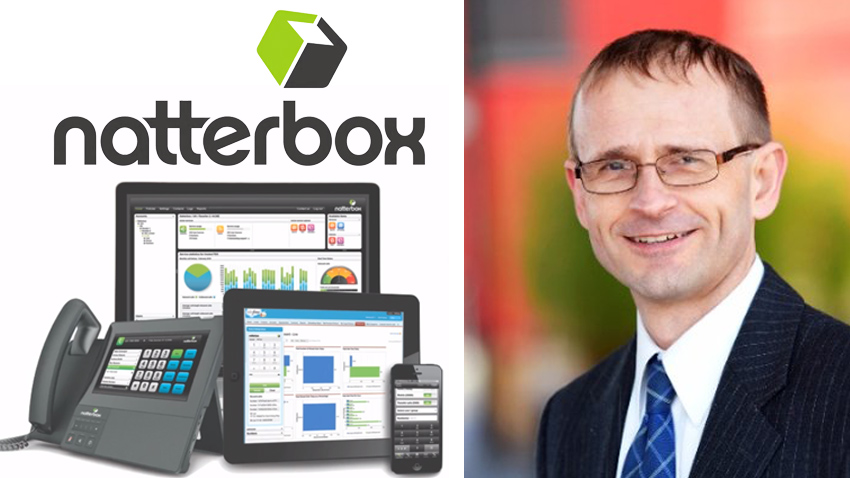For all the talk of multi-platform, multi-modal technologies in UC these days, there are still those who firmly believe the telephone remains top of the business telecoms tree.
Once such company is Natterbox. Based on the fact that two thirds of business interactions still take place over the telephone, Natterbox was founded in 2010 with a vision to reshape telephony services for the Cloud age.
UK Sales Director Ian Moyse explained some of the thinking behind Natterbox’s focus on the old school telephone.
“Many of the hosted Unified Communications players have ticked the horizontal boxes for breadth of function, but they lack depth of quality across all modes of communication, leaving customers less than pleased,” he said.
“Delivering consistently high quality calls anywhere in the world, so remote offices and roaming users can all benefit from one vendor’s platform, for example, is itself enough of a challenge. If a provider cannot achieve this for the fundamental phone call element, then layering chat, video and other comms over the top is not a smart move. It is one thing ticking boxes for the number of features you offer, but another to deliver the quality levels expected by users on any device, any time from anywhere.”
Customer experience
Not afraid to go against the grain of conventional thinking on hosted comms services, Natterbox has eschewed the broad vistas of the /unified-communications/ucaas model to focus squarely on delivering enterprise class cloud telephony. It has invested in building a single carrier network across Europe, North America, East Asia and Australia, and, as Ian explains, the driving factor behind its decision to focus on the Cloud is delivering excellence in service.
“An increased focus and recognition of the importance of the customer experience is driving businesses to explore any improvement and edge they can gain,” he said. “Website journeys are continually analysed for personalised and optimised customer experience, but phone journeys are not. They should be.”
“Cloud telephony can empower these needs quicker, easier and in greater depth than any legacy telephony system and this is disrupting the status quo of many traditional telecoms providers. The Cloud has disrupted many sectors – take CRM, where 70 per cent of new systems sold are now cloud based. Telephony is experiencing the same market shift.”
The mention of CRM and cloud-based market disruption are no accident. Both are topics very close to heart for Natterbox. In fact, its innovative solution to the challenge of improving customer experiences through cloud telephony has been to combine a phone system and CRM into one. In its Advanced Voice Services (AVS) platform, it has the world’s first and only Cloud PBX and contact centre solution designed to be run entirely within Salesforce.
Ian firmly believes that this disruptive cross-fertilisation of CRM with business telephony will be widely imitated in the future.
“CRM integration with telephony is a rapidly expanding sector and those who can deliver the best and most effective linkage here are going to grow rapidly,” he said.
“The key needs of digital transformation include removing complexity, increasing agility & flexibility and improving user experience, for both internal & external customers. User expectations are at a higher level than ever seen before and businesses need to be agile and flexible to keep up with them. But for people to adopt the required changes and be supportive of the transformation, they have to recognise the added value and believe in the end goal.
“Integrating cloud telephony as a native extension of CRM is a smart move because it extends the value of customer data. Companies have invested in tracking and personalising customer journeys online for years. By tying into your CRM, you can easily bring this sophistication to your customer phone experience, helping to create a shortened and more personalised journey each time.”
New rules
Ian argues that this kind of experience-led transformation of telephony is simply a natural continuation of changes the Cloud has made in contact centre operations.
“Cloud telephony is re-writing the rules for contact and call centre capabilities,” he said. “New platform offerings from cloud providers are delivering more agile, faster systems that will continue to push the bar in terms of function, flexibility and integration far beyond what is possible from legacy PBX systems.
“Fully integrating your telephone system with Salesforce, for example, takes this agility and intelligence to another level. It means you can have the customer and agent journey adapt automatically based on customer data.
“Here’s an example. Miss Smith has called out of hours and left a message asking if her delivery could be changed to Weds AM. The agent picks this up in the CRM next morning, schedules and adds a reply. The system texts that to Miss Smith, but also flags ready for an inbound call. Should Miss Smith call in again, she is presented with an automatically created IVR greeting – “Hi Miss Smith, if you are calling about your delivery change that has been rescheduled for Weds AM 9-12, please press 1. If you wish to hear our other options, please press 2,” and so on.
“A modern cloud contact centre system pulling data from a CRM can do wonderful things to reduce the customer’s IVR selections based on rules that present the most likely options and personalise the experience. This will help improve NPS scores, reduce customer frustrations and empower call agents to act more quickly with more information to help a customer.”
On top of improvements to service, Ian sees numerous other benefits to cloud telephony, from keeping up with rapid changes in technology to security compliance, especially with the GDPR looming.
“Cloud telephony also enables a business to change systems far more efficiently than ever before. A phone system refresh is reduced from weeks or longer, to days or even hours and means a business can feel less tied to old technology, removing the barrier of change from their decision-making process.”
“The GDPR is going to affect all businesses, both customer (data controller) and vendors (data processor) as the laws are heightened and punishments dramatically increased. Cloud telephony can bring great benefits to those seeking GDPR compliance. Having a recording of a customer’s verbal consent to use and store their data, for example, will be essential to mitigate any complaint where no other proof exists.”
“The Cloud enables these recordings to be stored cost effectively and linked automatically to customer CRM records, making it quick to retrieve when required, perhaps under a Subject Access Request.”
This article is part of the July Series of the Technology Track on Cloud Communications, follow the link to see all published and planned articles.







